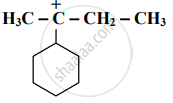Advertisements
Advertisements
प्रश्न
Find out the most stable species from the following. Justify.
\[\ce{\overset{+}{C}H3, \overset{+}{C}H2Cl, \overset{+}{C}Cl3}\]
उत्तर
The most stable species from the given species is `overset(+)("CH"_3)`
This because it does not contain Cl atom, which exhibits an electron-withdrawing inductive effect. Carbocations are destabilized by -I inductive (electron-withdrawing) effect. When more number of –I groups are attached to the positively charged carbon atom, the positive charge on the carbon atom increases further, thus destabilizing the species. Hence, the species with no –I groups will be most stable.
APPEARS IN
संबंधित प्रश्न
Identify the α - carbons in the following species and give the total number of α-hydrogen.

Identify the α-carbon in the following species and give the total number of α-hydrogens.
\[\ce{CH2 = CH - CH2 - CH3}\]
Distinguish between Electrophile and nucleophile.
Distinguish between Homolysis and heterolysis.
Write true or false. Correct the false statement.
Heterolytic fission results in the formation of free radicals.
Write true or false. Correct the false statement.
Free radicals are negatively charged species.
Choose the correct option.
The geometry of a carbocation is ______.
Choose the correct option.
The delocalization of electrons due to overlap between p orbital and sigma bond is called _______.
Which of the following compound is highly reactive towards HCN?
Which of the following is the strongest nucleophile?
Which of the following statements is INCORRECT about hyperconjugation?
Which among the following is a set of nucleophiles?
The +I inductive effect is shown by which of the following groups?
The most unstable free radical among the following is:
IUPAC name of ![]() is ______.
is ______.
The most probable product in the reaction given below is:

Which element among the following does form pπ - pπ multiple bonds?
Arrange the following free radicals in order of decreasing stability.
- Methyl
- Vinyl
- Allyl
- Benzyl
Identify the α-carbons in the following species and give the total number of α-hydrogen.
\[\ce{CH3 - CH2 - \overset{⊕}{C}H - CH2 - CH3}\]
Identify the α - carbons in the following species and give the total number of α-hydrogen.
\[\ce{CH3 - CH2 - \overset{⊕}{C}H - CH2 - CH3}\]
Identify the α-carbons in the following species and give the total number of α-hydrogen.
\[\ce{CH2 = CH - CH2 - CH3}\]
Identify the α-carbons in the following species and give the total number of α-hydrogen in it.
CH2 = CH − CH2 − CH3
Identify the α-carbon in the following species and give the total number of α-hydrogen.
\[\ce{CH3 - CH2 - \overset{⊕}{C}H - CH2 - CH3}\]
Identify the α-carbons in the following species and give the total number of α-hydrogen.
\[\ce{CH2 = CH - CH2 - CH3}\]
Identify the α - carbon in the following species and give the total number of α-hydrogen.
\[\ce{CH2 = CH - CH2 - CH3}\]
Identify the α-carbons in the following species and give the total number of α-hydrogens.
\[\ce{CH3 - CH2 - \overset{⊕}{C}H - CH2 - CH3}\]
